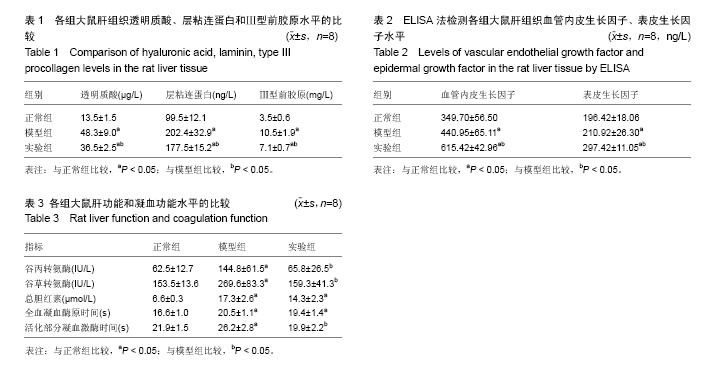| [1] Garcia-Monzon C,Sanchez-Madrid F,Garcia-Buey L,et al. Vascular adhesion molecule expression in viral chronic hepatitis: evidence of neoangiogenesis in portal tracts. Gastroenterology.1995;108(1):231-241.[2] Corpechot C,Barbu V,Wendum D,et al. Hypoxia-induced VEGF and collagen I expressions are associated with angiogenesis and fibrogenesis in experimental cirrhosis. Hepatology. 2002;35(5):1010-1021.[3] Lan L,Chen Y,Sun C,et al.Transplantation of bone marrow-derived hepatocyte stem cells transduced with adenovirus-mediated IL-10 gene reverses liver fibrosis in rats. Transpl Int.2008;21(6):581-592.[4] Gupta S,Rajvanshi P,Malhi H,et al.Cell transplantation causes loss of gap junctions and activates GGT expression permanently in host liver.Am J Physiol Gastrointest Liver Physiol. 2000;279(4):G815-826.[5] Joseph B,Malhi H,Bhargava KK,et al.Kupffer cells participate in early clearance of syngeneic hepatocytes transplanted in the rat liver.Gastroenterology.2002;123(5): 1677-1685.[6] Min AD,Theise ND.Prospects for cell-based therapies for liver disease. Panminerva Med.2004;46(1):43-48.[7] Timmermans F,Plum J,Yoder MC,et al.Endothelial progenitor cells: identity defined?J Cell Mol Med.2009;13(1):87-102.[8] 刘冉,兰玲,刘博伟,等.肝纤维化大鼠骨髓源性内皮祖细胞的培养及鉴定[J].基础研究与临床,2011,31(12):1335-1340.[9] 兰玲,于静,刘冉,等.骨髓内皮祖细胞输注后在肝纤维化大鼠肝脏内的示踪研究[J].中华器官移植杂志,2012,33(11):684-688.[10] Rautou PE.Endothelial progenitor cells in cirrhosis: The more,the merrier? J Hepatol.2012;57(6):1163-1165.[11] Shirakura K,Masuda H,Kwon SM,et al.Impaired function of bone marrow-derived endothelial progenitor cells in murine liver fibrosis.Biosci Trends.2011;5(2):77-82.[12] Fadini GP,Losordo D,Dimmeler S.Critical reevaluation of endothelial progenitor cell phenotypes for therapeutic and diagnostic use.Circ Res.2012;110:624-637.[13] Dome B,Dobos J,Tovari J,et al.Circulating bone marrow-derived endothelial progenitor cells: characterization, mobilization, and therapeutic considerations in malignant disease.Cytometry A.2008;73(3):186-193. [14] Papathanasopoulos A,Giannoudis PV. Biological considerations of mesenchymal stem cells and endothelial progenitor cells.Injury.2008;39 Suppl 2:S21-32.[15] Garcia-Pagan JC,Gracia-Sancho J,Bosch J. Functional aspects on the pathophysiology of portal hypertension in cirrhosis.J Hepatol.2012;57:458-461.[16] Forbes SJ,Gupta S,Dhawan A.Cell therapy for liver disease: From liver transplantation to cell factory.J Hepatol.2015;62(1 Suppl):S157-169.[17] Sabatier F,Camoin-Jau L,Anfosso F,et al.Circulating endothelial cells, microparticles and progenitors: key players towards the definition of vascular competence.J Cell Mol Med.2009;13:454-471.[18] Gressner AM,Weiskirchen R,Breitkopf K,et al. Roles of TGF-beta in hepatic fibrosis. Front Biosci.2002;7:d793-807.[19] Gressner AM,Weiskirchen R.The tightrope of therapeutic suppression of active transforming growth factor-beta: high enough to fall deeply? J Hepatol.2003;39(5): 856-859[20] Medina J,Arroyo AG,Sanchez-Madri F,et al.Angiogenesis in chronic inflammatory liver disease. Hepatology. 2004; 39(5): 1185-1195.[21] Thabut D,Shah V.Intrahepatic angiogenesis and sinusoidal remodeling in chronic liver disease: new targets for the treatment of portal hypertension?J Hepatol.2010;53:976-980.[22] Lian J,Lu Y,Xu P,et al.Prevention of Liver Fibrosis by Intrasplenic Injection of High-Density Cultured Bone Marrow Cells in a Rat Chronic Liver Injury Model.PLoS One.2014;9(9): e103603.[23] Nakamura T,Torimura T,Iwamoto H,et al.Prevention of liver fibrosis and liver reconstitution of DMN-treated rat liver by transplanted EPCs.Eur J Clin Invest.2012;42(7):717-728.[24] Nakamura T,Torimura T,Sakamoto M,et al.Significance and therapeutic potential of endothelial progenitor cell transplantation in a cirrhotic liver rat model. Gastroenterology. 2007;133(1):91-107 e101.[25] Sakamoto M,Nakamura T,Torimura T,et al.Transplantation of EPCs ameliorates vascular dysfunction and portal hypertension in CCl(4)-induced rat liver cirrhotic model.J Gastroenterol Hepatol.2013;28(1):168-178. [26] Bahde R,Kapoor S,Viswanathan P,et al.Endothelin-1 receptor A blocker darusentan decreases hepatic changes and improves liver repopulation after cell transplantation in rats. Hepatology.2014;59:1107-1117.[27] Bahde R,Kapoor S,Bandi S,et al.Directly acting drugs prostacyclin or nitroglycerine and endothelin receptor blocker bosentan improve cell engraftment in rodent liver.Hepatology. 2013;57:320-330.[28] Liu FFei RRao HYet al.The effects of endothelial progenitor cell transplantation in carbon tetrachloride induced hepatic fibrosis rats.Zhonghua Gan Zang Bing Za Zhi.2007;15(8): 589-592.[29] Gressner OA,Weiskirchen R,Gressner AM.Biomarkers of liver fibrosis: clinical translation of molecular pathogenesis or based on liver-dependent malfunction tests. Clin Chim Acta. 2007;381(2):107-113.[30] Vanheule E,Geerts AM,Van Huysse J,et al.An intravital microscopic study of the hepatic microcirculation in cirrhotic mice models:relationship between fibrosis and angiogenesis. Int J Exp Pathol.2008;89(6):419-432.[31] Giatromanolaki A,Kotsiou S,Koukourakis MI,et al.Angiogenic factor expression in hepatic cirrhosis. Mediators Inflamm. 2007; (2007):67187.[32] SMadja DM,Cornet A,Emmerich J,et al.Endothelial progenitor cells:characterization,in vitro expansion,and prospects for autologus cell therapy.Cell Biol Toxicol.2007;23(4):223-239. |
.jpg)

